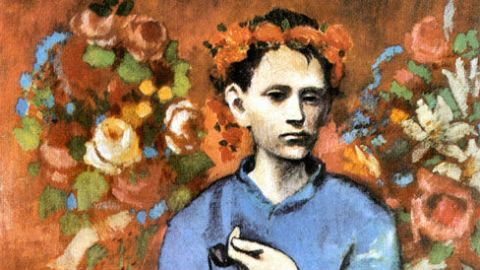See Like a Child, Paint Like Picasso

What’s the Big Idea?
It took me four years to paint like Raphael, but a lifetime to paint like a child, said Picasso. A study from the University of California, San Diego, suggests why. Infants perceive the world in a fundamentally different way than typical adults, in which the senses are joined.
The authors of the study, Katie Wagner and Karen R. Dobkins, observe that early childhood development is characterized by “a period of exuberant neural connectivity” that may facilitate “arbitrary sensory experiences in infants that are unlike anything experienced by typical adults.” These experiences are similar to the condition found in some adults that is known as synesthesia, a neurological condition in which two or more bodily senses are merged.
The study found this sensory phenomenon is most pronounced in infants that are between two and three months old. By eight months, it has vanished altogether.
What’s the Significance?
The San Diego study sheds new light on cognitive development and offers insight into a neurological condition that continues to fascinate us because it bucks an evolutionary trend. Our senses function separately so that we can perceive with clarity the ripeness of fruit, the sound of danger. Love perhaps still confounds us, as we seek out the site, scent and caress of the right mate.
People with synesthesia, on the other hand, “experience the world in extraordinary ways,” writes the neuroscientist Dr. V.S. Ramachandran in his book, The Tell-Tale Brain. These so-called synesthetes “inhabit a strange no-man’s-land between reality and fantasy. They taste colors, see sounds, hear shapes, or touch emotions in myriad combinations.”
It is not surprising then, that this condition is such an appealing one to artists who have sought to defamiliarize their perceptions of reality, or, to put it another way, to rediscover a primal, childlike perception of reality. According to Ramchandran, synesthesia is seven times more common in artists.
Synesthesia can be found in the works of the French Symbolist poets, notably Arthur Rimbaud and Charles Baudelaire, and it is echoed in the visions of the Surrealist painters such as Man Ray and Meret Oppenheim. “It is imagination that first taught man the moral meaning of color, of contour, of sound, and of scent,” wrote the synesthete Baudelaire, who wrote of perfumes fresh like the skin of infants and the scent of a woman’s breast as the perfume of an exotic island. Baudelaire’s fellow enfant terribleArthur Rimbaud would later take synesthetic expression to new heights with his sonnet “Vowels” by assigning a color to each vowel:
A black, E white, I red, U green, O blue: vowels,
I shall tell, one day, of your mysterious origins!
[A noir, E blanc, I rouge, U vert, O bleu: voyelles,
Je dirai quelque jour vos naissances latentes!]
As a teenager, Rimbaud embarked on a shaman-like quest to become a “seer” through the “reasoned derangement of the senses.” (Le Poète se fait voyant par un long, immense et raisonné dérèglement de tous les sens.) This meant writing under the heavy influence of hashish and absinthe. Indeed, synesthetic perception has been associated with hallucinogenic drugs such as mescaline, hashish and LSD (suggesting that these drugs enhance a preexisting condition in humans–more on that later…). And yet, the key word in Rimbaud’s formulation is “reasoned” (raisonné). That is to say, while synesthesia has been observed to be involuntary and automatic, Rimbaud’s poetic quest involved a deliberate, rational choice to alter his senses. There was method to his madness.
This concept caught fire with the Surrealists decades later. What Rimbaud did to language the Surrealists did to objects, fundamentally transforming them like Man Ray’s photograph that presents a woman’s body as a musical instrument:
Or consider Meret Oppenheim’s iconic fur-lined cup, which appears so warm and cozy you might want to snuggle up in it, but you would never want to eat your breakfast out of it.
Synesthesia is found in musicians as well. According to an 1895 German article:
When Liszt first began as Kapellmeister in Weimar (1842), it astonished the orchestra that he said: ‘O please, gentlemen, a little bluer, if you please! This tone type requires it!’ Or: ‘That is a deep violet, please, depend on it! Not so rose!’ First the orchestra believed Liszt just joked;… later they got accustomed to the fact that the great musician seemed to see colors there, where there were only tones.
The common gesture that unites all of the works cited here is an attempt to transcend the senses and liberate the imagination. In other words, these artists are looking to fulfill Picasso’s lifelong quest to be able to paint like a child. So is this ability accessible to all of us, or is it only found in rare geniuses?
We don’t have a complete answer to that question. Ramachandran suggests that artists are simply better at crafting metaphors, but they certainly don’t have a monopoly on metaphor. We use synesthetic metaphors in our everyday language, such as hot babe, or flat soda. So a better way to put it would be this: Artists are better at metaphors “because they are synesthetes.”
Moreover, at some level we are all synesthetes, argues Ramachandran. After all, “the use of metaphor and our ability to uncover hidden analogies is the basis of all creative thought.”
In this sense, synesthetic perceptions help us experience life in a richer context, maintain healthier brains, and it also helps us with problem solving. Just as Picasso spent his life trying to paint like a child, Ramachandran quotes Sherlock Holmes’s life quest: “My life is spent in one long effort to escape the commonplaces of existence.”
Megan Erickson contributed to this article.
Image courtesy of Shutterstock
Follow Daniel Honan on Twitter @Daniel Honan





